Magic and Autism
- Posted 12.02.10
- NOVA scienceNOW
Tapping into social cues to trick their audience, magicians rely on a phenomenon called joint attention. Most audience members will pay attention to what a magician is looking at—so a magician can direct their attention away by looking in the opposite direction. People on the autistic spectrum can have trouble picking up on the cues of joint attention and may not be fooled by a magician's sleight of hand. Researchers are now looking to magic as a useful technique to teach children with autism how to read social cues.
Transcript
Magic and Autism
Posted: December 2, 2010
NARRATOR: Neuroscientists Susana Martinez Conde and Steven Macknik think magic tricks, like this one performed by Penn and Teller...
PENN JILETTE: We take the ball and we place it on our hand. We vanish it and it appears underneath the cup.
NARRATOR: ...might not fool people with autism.
SUSANA MARTINEZ CONDE (Barrow Neurological Institute): Our hypothesis is that magic tricks that rely on social cues will be less effective in people with autism.
STEVEN MACKNIK (Barrow Neurological Institute): Many autistics have a very difficult time paying attention to what other people are paying attention to. They are very bad at this.
STEVEN SHORE (Adelphi University): If I shift my gaze up there [looks off to the side], especially do something like that [looks hard in that direction], then you are probably going to look, and see what I am looking at. That's joint attention. Someone on the autism spectrum might not be able to perceive this non-verbal communication, and as a result they may be looking right at the magician's hands or somewhere where the magician would rather not have people look.
NARRATOR: Steven Shore, special ed. teacher at Adelphi University, knows this all to well. Steven has autism, and when he was eight years old he saw a magic trick he will never forget.
SHORE: I was watching a magician, and I guess I was looking where I shouldn't have been looking, and I was able to see the workings of the illusion, and it didn't occur to me that nobody else understood how the trick worked.
NARRATOR: So if a magician's sleight of hand can't fool people with autism, then perhaps it can be used to help them.
PETER MUNDY (University of California, Davis): Magic is so interesting to children you might be able to flip it on its head and use it as an intervention technique. You know, teach children with autism how to follow the gaze of the magician in order to better understand social attention.
Credits
- Produced for NOVA scienceNOW by
- Terri Randall
- Video
- (all) © WGBH Educational Foundation
Sources
Further reading
Macknik, Stephen L. and Susana Martinez-Conde with Sandra Blakeslee (2010) Sleights of Mind: What the Neuroscience of Magic Reveals About Our Everyday Deceptions, New York: Henry Holt and Co.
www.sleightsofmind.com
Related Links
-

Magic and the Brain
Neuroscientists join Penn and Teller to explore why humans are so easily fooled by magic tricks.
-

Autism Genes
Researchers have begun to zero in on genes that might be responsible for autism.
-

Autism Genes: Expert Q&A
Charles Nelson of Children's Hospital Boston answers questions about the research, diagnosis, and treatment of autism.



